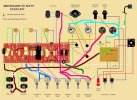ThreeChordWonder
Well-Known Member
- Joined
- Jan 31, 2021
- Messages
- 485
- Reaction score
- 564
Coming along quite nicely, although I'm one capacitor short of a circuit board [thats a new way of putting it, right?].
As I've said before, I've upped the specified 1/2-watt resistors to 1-watt, 1-watt yo 2-watt, etc., so there's a big 1K 10W on the left.
Some components are only tack-soldered right now, as I have wires to fit in the holes.
The white wires will go to my off-board tube bias pot.
I will be tapping at the 100 nF / 220k junctions, for my PPIMV. That will be a dual 250k pot with 2.2M bleed resistors. Normally those junctions go by wires to 5.1K resistors attached to pins 5 (control grids) on the EL34 power tube sockets. I'm just interrupting the connections with a dual pot and bleed resistors.
The ground bus is in, on top the board. 18 awg single core. I'm not sure whether bare wire on top is a good idea though. Thoughts anyone? I can re-do it on the bottom and use insulated wire if that's required.

As I've said before, I've upped the specified 1/2-watt resistors to 1-watt, 1-watt yo 2-watt, etc., so there's a big 1K 10W on the left.
Some components are only tack-soldered right now, as I have wires to fit in the holes.
The white wires will go to my off-board tube bias pot.
I will be tapping at the 100 nF / 220k junctions, for my PPIMV. That will be a dual 250k pot with 2.2M bleed resistors. Normally those junctions go by wires to 5.1K resistors attached to pins 5 (control grids) on the EL34 power tube sockets. I'm just interrupting the connections with a dual pot and bleed resistors.
The ground bus is in, on top the board. 18 awg single core. I'm not sure whether bare wire on top is a good idea though. Thoughts anyone? I can re-do it on the bottom and use insulated wire if that's required.







